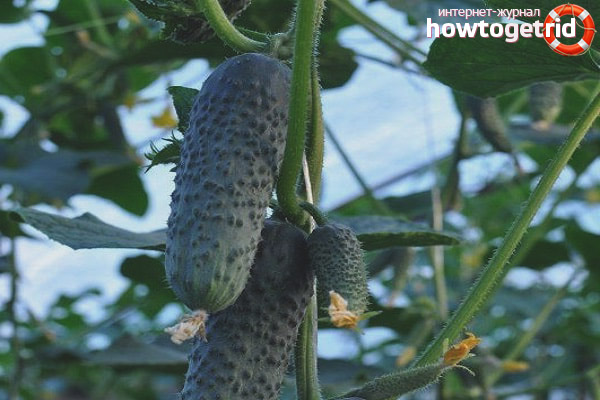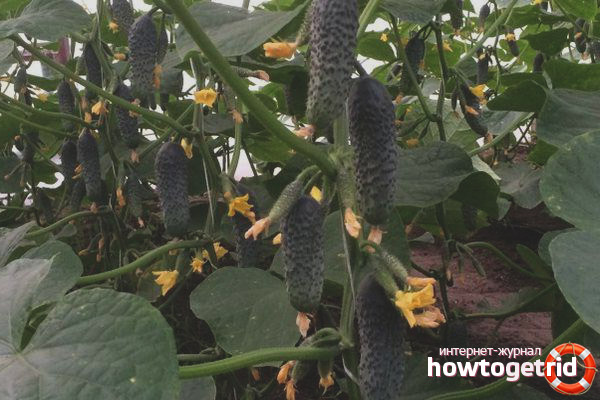The content of the article
Among summer residents and gardeners there is an opinion that high-quality varieties and hybrids of cucumbers must necessarily be of Dutch production. But the Yuksel seed company has proven that not only the Dutch can produce excellent hybrids. The proof of this is the cucumber "Lutoyar F1", formerly called "Janissary". It successfully combines qualities such as an early maturity, high rates of yield, taste and resistance to disease.
Characteristics and features of the hybrid
Self-pollinated (parthenocarpic) hybrid of a gherkin of a gherkin type. Bred by breeders of the world famous Turkish company Yuksel Seeds. The ultra-early ripening period, from the appearance of seedlings to the beginning of fruiting, takes 33-35 days. The hybrid is characterized by flowers of a predominantly female type.
The plant is vigorous, medium-branched. In each bosom of the leaves, 2-3 fruit ovaries form. The leaves are dark green, pubescent. Zelentsy are coarse, densely pubescent, with sharp white spines. They are saturated dark green in color, with slight lighter, yellowish stripes on the sides of the fruit.
The fruits are fleshy, dense, seasonally 10-12 cm long and weighing 90-110 gr., 2.5-3.5 cm in diameter. Lutoyar F1 cucumbers are very tasty, sweet. The pulp is dense, but juicy, without voids. It has a rich cucumber flavor. Resistant to major diseases and pests of cucumbers. Namely - to gray and white rot, causing significant damage to the plantings of cucumbers.
Application
The fruits of Lutoyar F1 are universal in application. This is an excellent choice, first of all, for the sale of very early, expensive products in the wholesale and retail markets of vegetables. And also for fresh consumption, cooking various salads and decorating dishes. Possible picking at the stage of picks, becoming increasingly popular. The fruits retain the high quality and dense structure of the pulp during conservation, pickling and pickling.
Hybrid Strengths
- High self-pollination ability. The hybrid does not need pollinating insects (bees, bumblebees).
- Good resistance to major diseases and pests of cucumbers.
- Suitability for cultivation in the spring-summer and summer-autumn season. As well as growing in winter in heated greenhouses with artificial lighting.
- Stretched fruiting period, allowing a long time to produce fruit sampling.
- Very high palatability, juicy, aromatic pulp without voids.
- Unpretentiousness, good adaptation to various growing conditions, suitability for cultivation on heavy soils.
- On 1 bush at the same time can ripen up to 20 fruits that maintain high quality.
- A high percentage of fruits of the 1st grade, Zelentsy retain their presentation and quality for a long time after collection.
- High stress resistance, in particular resistance to temperature differences. High percentage of fruit set in hot weather.
- Consistently high yields.
- There are practically no seeds in the pulp.
- The ability to grow a hybrid in a horizontal culture, just letting go in the garden.
- Suitability for both amateur, small-scale cultivation and industrial cultivation over large areas.
The secrets of successfully growing a hybrid
- The recommended planting scheme on an industrial scale is 30-50 thousand plants per 1 ha. Or from 2 to 4 plants per 1 sq. Km. m. for amateur cultivation. Moreover, both a single-line and a two-line landing scheme are possible.The hybrid is not shade resistant; landing in well-lit areas is necessary.
- Since the hybrid has a high yield and an extended fruiting period, it is necessary to regularly and fully provide it with food. Namely, to carry out treatment with complex fertilizers and growth stimulators with an interval of 7-10 days. And also alternate root and foliar top dressing.
- Carrying out preventive examinations and sanitary cleaning of landings. As well as regular loosening of the soil between the rows and weeding of weeds.
- Comprehensive chemical protection against a wide range of diseases and pests. The use of compatible fungicides and insecticides in tank mixtures with adhesives. The frequency of treatments is 2-3 per season.
- Sowing seeds for seedlings in late February - early March. Depth of seeds into the soil - by 1.5-2 cm.
- Watering seedlings with settled, warm water. Periodically sprayed with water to increase humidity.
- Preplanting soil preparation. It is carried out in the fall or a month before transplanting. Rotted manure or chicken droppings are introduced, followed by plowing or digging the site. It is advisable to conduct soil spills from pests using insecticides such as Antichrush, Aktara, Nurell D.
- Planting protection from drafts, especially when grown in early spring.
- Shading of cucumbers in particularly hot summer months.
- Providing regular, plentiful watering of plants. If necessary, mulch the plantings with organics (mowed siderates, straw) or non-woven material (agrofibre, spanbond).
Reviews of summer residents of the hybrid
- Andrey Skantsev, 38 years old: One of the best early hybrids for business. This year I was convinced personally. I usually planted Meringue from Seminis. And this season I decided to plant a part of the greenhouse with a novelty. New to me. They advised to try Turkish Lutoyar. He grew seedlings in February, in March he already replanted them in a greenhouse. The greenhouse is heated by the way. What can I say - satisfied. Not inferior in anything to Meringue. Productivity at heights, delicious cucumbers, good commercial qualities. And they really began to ripen very early. Now I will grow constantly.
- Ala, 28 years old: They built a greenhouse a year ago. And the first cucumbers that appeared there were just Lutoyar. What I liked, the plants were healthy, strong, practically did not hurt anything. Very abundantly and early fruit. Just choose them often. In a day, two. And what a delicious, crispy! Recomend for everybody.
Video: Lutoyar F1 cucumbers











Submit